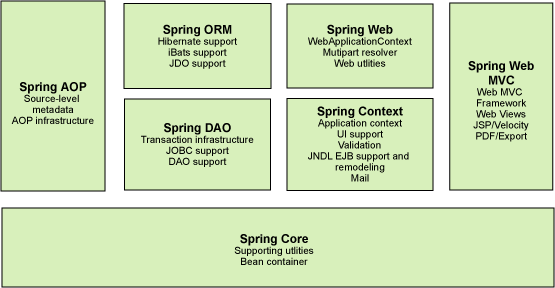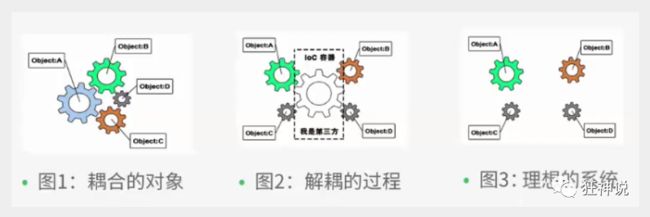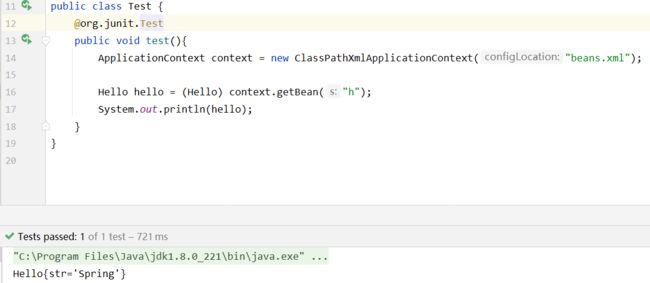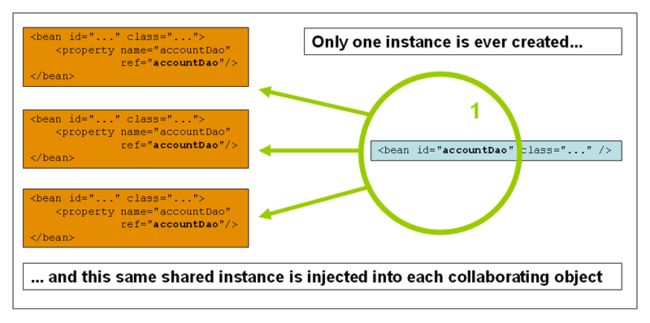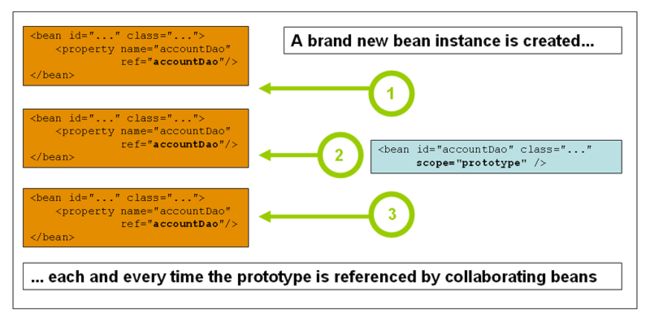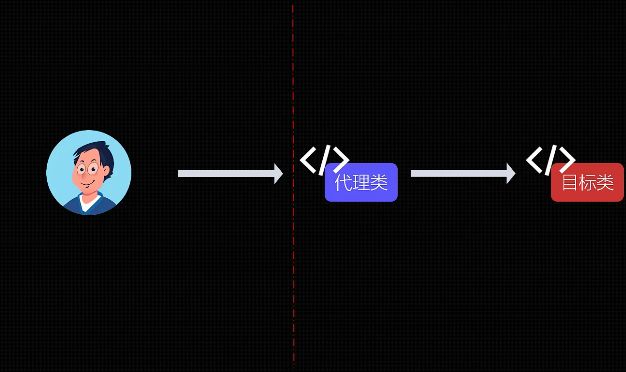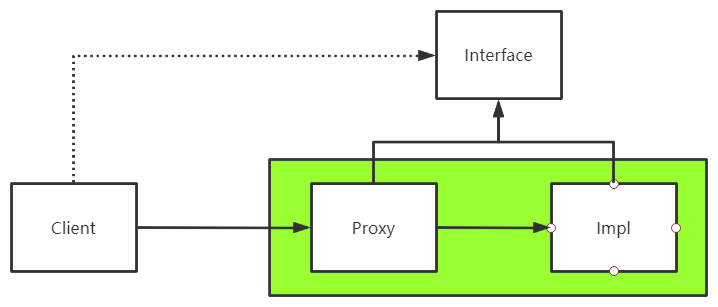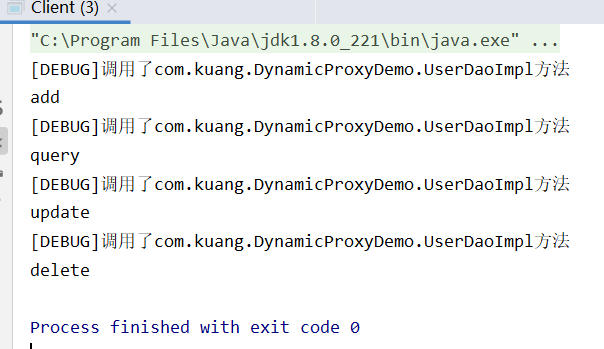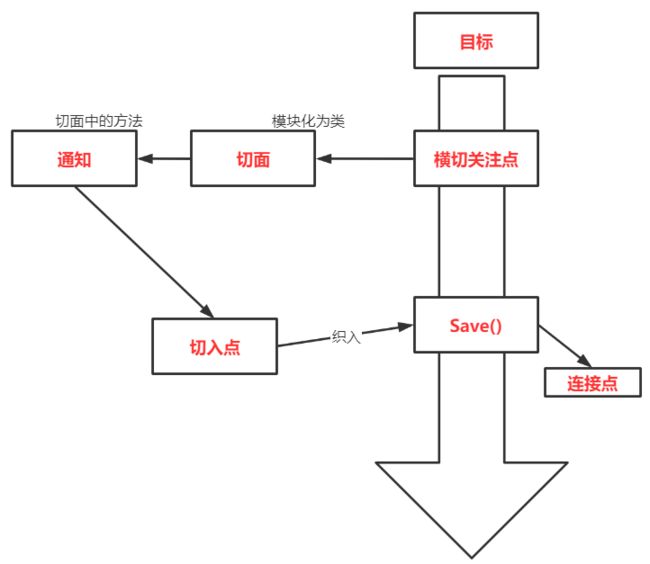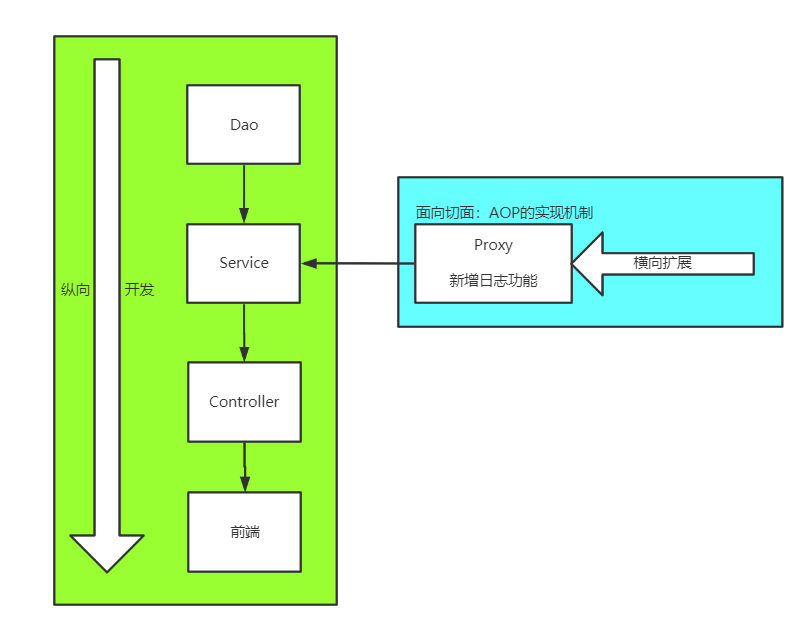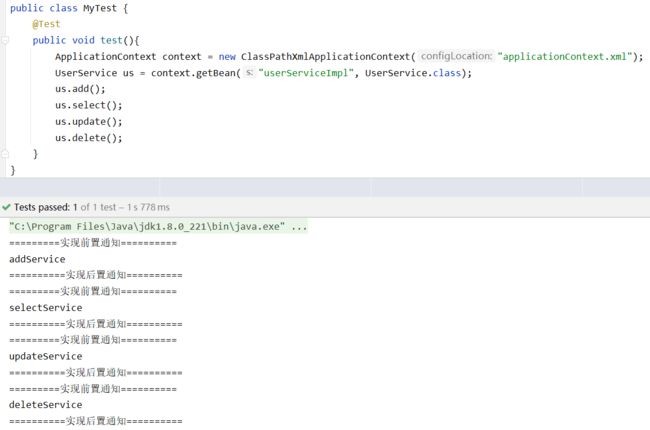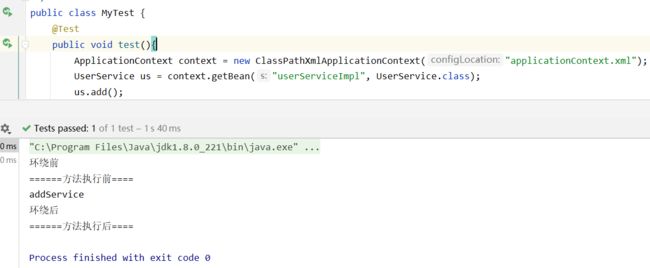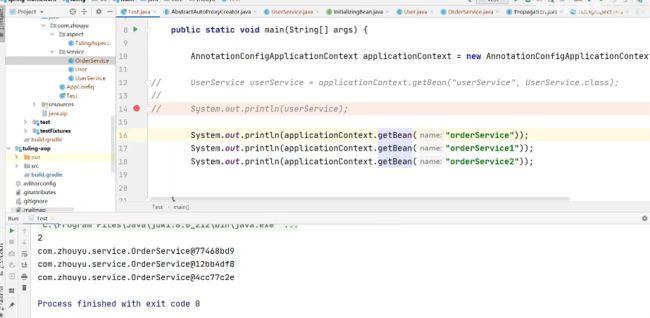【开发】后端框架——Spring
前置知识:JSP&Servlet
学习视频:https://www.bilibili.com/video/BV1WE411d7Dv?spm_id_from=333.999.0.0
-
IoC:控制反转
IoC的理解:IoC思想,IoC怎么创建对象,IoC是Spring的核心
依赖注入三种方式:构造器、set方法、第三方
-
Bean的作用域:2+4
单例与原型
request,session,appication=websocket
-
Bean属性的自动装配:四种
xml显示配置
隐式自动配置(ByName——参数名,ByType——参数类型)
注解
实现配置类:不用xml配置,把配置项作为类属性
-
Bean的生命周期
-
代理模式
-
AOP
Spring
Spring简介
解决企业级应用开发的复杂性创建,简化开发
轻量级控制反转(IOC)和面向切面编程(AOP)的容器框架
- 2002,interface21 Spring框架雏形
- Spring理念:整合现有的框架
- SSH:Struct2 + Spring + Hibernate
- SSM:SpringMVC + Spring + MyBatis
官网
文档地址
各版本文档
下载地址
<dependency>
<groupId>org.springframeworkgroupId>
<artifactId>spring-webmvcartifactId>
<version>5.3.3version>
dependency>
<dependency>
<groupId>org.springframeworkgroupId>
<artifactId>spring-jdbcartifactId>
<version>5.3.3version>
dependency>
优点
- 开源的框架
- 轻量级的、非入侵式的框架
- 控制反转(IOC)、面向切面编程(AOP)
- 支持事务处理
- 对框架整合的支持
弊端:发展太久,配置十分繁琐
- 配置地狱
组成
拓展
- Spring Boot:快速开发脚手架
- 快速开发单个微服务
- 约定大于配置
- Spring Cloud:协调
- 基于Spring Boot实现
- 微服务的整合
IoC容器
为什么有IoC思想
以JDBC连接数据库为例
原先
-
UserDao接口
public interface UserDao { public void getUser(); } -
UserDaoImpl实现类
//UserDaoImpl.class public class UserDaoImpl implements UserDao{ public void getUser(){ System.out.println("获取用户数据"); } } //UserDaoMysqlImpl public class UserDaoMysqlImpl implements UserDao{ public void getUser(){ System.out.println("MySql获取用户数据"); } } //UserDaoOracleImpl public class UserDaoOracleImpl implements UserDao{ public void getUser(){ System.out.println("Oracle实现获取用户数据"); } } -
UserService业务接口
public interface UserService { public void getUser(); } -
UserServicelmpl业务实现类
public class UserServiceImpl implements UserService{ private UserDao userDao = new UserDaoMysqlImpl(); // = new UserDaoOracleImpl(); // = new UserDaoImpl(); public void getUser(){ userDao.getUser(); } } -
MyTest
public class MyTest { public static void main(String[] args) { //用户实际调用的是业务层 UserService userService = new UserServiceImpl(); userService.getUser(); } }
IoC雏形
-
UserDao接口
public interface UserDao { public void getUser(); } -
UserDaoImpl实现类
//UserDaoImpl.class public class UserDaoImpl implements UserDao{ public void getUser(){ System.out.println("获取用户数据"); } } //UserDaoMysqlImpl public class UserDaoMysqlImpl implements UserDao{ public void getUser(){ System.out.println("MySql获取用户数据"); } } //UserDaoOracleImpl public class UserDaoOracleImpl implements UserDao{ public void getUser(){ System.out.println("Oracle实现获取用户数据"); } } -
UserService业务接口
public interface UserService { public void getUser(); } -
UserServicelmpl业务实现类
public class UserServiceImpl implements UserService{ private UserDao userDao; public void setUserDao(UserDao userDao){ this.userDao = userDao; } public void getUser(){ userDao.getUser(); } } -
MyTest
public class MyTest { public static void main(String[] args) { //用户实际调用的是业务层 UserService userService = new UserServiceImpl(); ((UserServiceImpl)userService).setUserDao(new UserDaoOracleImpl()); userService.getUser(); } }
控制反转关键
public void setUserDao(UserDao userDao){
this.userDao = userDao;
}
之前,程序主动创建对象,控制权在程序
使用set注入,程序变成了被动接收对象
- 程序员不用再去管理对象的创建
- 系统的耦合性降低,更加专注在业务实现上,这是IOC的原型
IoC是Spring框架的核心
控制反转是一种通过描述(XML或注解)及第三方去生产或获取特定对象的方式
-
可使用XML配置
采用XML方式配置Bean,Bean的定义与实现分离
-
使用注解配置
采用注解方式将Bean的定义和实现合为一体
Bean的定义信息直接以注解的形式定义在实现类中,从而达到零配置目的
IOC是一种设计思想,DI(依赖注入)是实现IOC的一种方法,在Spring中实现IoC的是IoC容器
控制反转:获得对象的方式反转
- 程序由主动创建对象变为被动接收对象
依赖注入
- 利用set方法进行注入
Spring通过IoC容器完成对实例的创建,装配,管理
- 不再需要改动程序,要实现不同的操作,只需在xml配置文件中进行修改
相关jar包
Theorg.springframework.beansandorg.springframework.contextpackages are the basis for Spring Framework’s IoC container.
<dependency>
<groupId>org.springframeworkgroupId>
<artifactId>spring-beansartifactId>
<version>5.2.0.RELEASEversion>
dependency>
<dependency>
<groupId>org.springframeworkgroupId>
<artifactId>spring-contextartifactId>
<version>5.2.0.RELEASEversion>
dependency>
xml方式
beans.xml
<beans xmlns="http://www.springframework.org/schema/beans"
xmlns:xsi="http://www.w3.org/2001/XMLSchema-instance"
xsi:schemaLocation="http://www.springframework.org/schema/beans
https://www.springframework.org/schema/beans/spring-beans.xsd">
<bean id="userServiceImpl" class="com.kuang.service.UserServiceImpl">
<property name="userDao" ref="userDaoMysqlImpl"/>
bean>
beans>
获取IoC容器(Spring的Context对象)中类资源
The BeanFactory interface provides an advanced configuration mechanism capable of managing any type of object. ApplicationContext is a sub-interface of BeanFactory.
BeanFactory 定义了能够管理所有类的配置机制,ApplicationContext 是其子接口
ApplicationContext applicationContext = new ClassPathXmlApplicationContext("");
The ApplicationContext is the interface for an advanced factory capable of maintaining a registry of different beans and their dependencies. By using the method T getBean(String name, Class, you can retrieve instances of your beans.
ApplicationContext 是维护不同bean及其相关依赖的注册工厂
test
@Test
public void test(){
ApplicationContext applicationContext = new ClassPathXmlApplicationContext("beans.xml");
//对象由主动创建变为被动接收
UserService userService = (UserServiceImpl) applicationContext.getBean("userServiceImpl");
userService.getUser();
}
Spring配置
bean
<bean id="hello" class="com.kuang.pojo.Hello" name="hello2,u2">
<constructor-arg name="str" value="Spring"/>
bean>
- The
property nameelement refers to the name of the JavaBean property - and the
refelement refers to the name of another bean definition.
The id attribute is a string that identifies the individual bean definition.
The class attribute defines the type of the bean and uses the fully qualified classname.
全限定名:包名.类型
If you want to introduce other aliases for the bean, you can also specify them in the name attribute, separated by a comma (,), semicolon (;), or white space
bean别名——alias
<bean id="hello" class="com.kuang.pojo.Hello">
<constructor-arg name="str" value="Spring"/>
bean>
<alias name="hello" alias="h"/>
import
将多个配置文件导入到一个,便于统一管理
<import resource="beans1.xml">
<import resource="beans2.xml">
<import resource="beans3.xml">
依赖注入
- 依赖:bean对象的创建依赖于IoC容器
- 注入:bean对象中的所有属性,由容器来注入
1. IoC创建对象方式——构造器注入
在配置文件加载时,容器中管理的对象就已被初始化
默认使用无参构造器创建对象
使用有参构造器构造对象
-
下标赋值-index
<bean id="hello" class="com.kuang.pojo.Hello"> <constructor-arg index="0" value="Spring"/> bean> -
参数类型匹配-type
<bean id="hello" class="com.kuang.pojo.Hello"> <constructor-arg type="java.lang.String" value="Spring"/> bean> -
直接通过参数名设置-name
<bean id="hello" class="com.kuang.pojo.Hello"> <constructor-arg name="str" value="Spring"/> bean>
2. set注入
public class Student {
private String name;//基本数据类型 DI
private Address address;//引用数据类型 DI
private String[] books;//数组 DI
private List<String> hobbys;//List DI
private Map<String,String> card;// Map DI
private Set<String> games;//Set DI
private String wife;//null DI
private Properties info;//properties DI
}
基本数据类型
<bean id="student" class="com.kuang.pojo.Student">
<property name="name" value="Auspice Tian"/>
bean>
bean
<bean id="beijing" class="com.kuang.pojo.Address">
<property name="address" value="北京"/>
bean>
<bean id="student" class="com.kuang.pojo.Student">
<property name="address" value="beijing"/>
bean>
array
<property name="books">
<array>
<value>红楼梦value>
<value>西游记value>
<value>水浒传value>
<value>三国演义value>
array>
property>
list
<property name="hobbys">
<list>
<value>gggvalue>
<value>pppvalue>
<value>zzzvalue>
list>
property>
map
<property name="card">
<map>
<entry key="身份证" value="123456789111111"/>
<entry key="学生证" value="123456489789789"/>
map>
property>
set
<property name="games">
<set>
<value>LOLvalue>
<value>COCvalue>
<value>BOBvalue>
set>
property>
null
<property name="wife">
<null>null>
property>
property
<property name="info">
<props>
<prop key="driver">driverprop>
<prop key="url">urlprop>
<prop key="username">rootprop>
<prop key="password">2017002231prop>
props>
property>
第三方注入
可直接注入基本数据类型和bean
p-namespace(set注入)
导入约束:xmlns:p=“http://www.springframework.org/schema/p”
<beans xmlns="http://www.springframework.org/schema/beans"
xmlns:xsi="http://www.w3.org/2001/XMLSchema-instance"
xmlns:p="http://www.springframework.org/schema/p"
xsi:schemaLocation="http://www.springframework.org/schema/beans
https://www.springframework.org/schema/beans/spring-beans.xsd">
<bean name="john-modern" class="com.example.Person"
p:name="John Doe"
p:spouse-ref="jane"/>
<bean name="jane" class="com.example.Person">
<property name="name" value="Jane Doe"/>
bean>
beans>
c-namespace(constructor注入)
导入约束:xmlns:c=“http://www.springframework.org/schema/c”
<beans xmlns="http://www.springframework.org/schema/beans"
xmlns:xsi="http://www.w3.org/2001/XMLSchema-instance"
xmlns:c="http://www.springframework.org/schema/c"
xsi:schemaLocation="http://www.springframework.org/schema/beans
https://www.springframework.org/schema/beans/spring-beans.xsd">
<bean id="beanTwo" class="x.y.ThingTwo"/>
<bean id="beanThree" class="x.y.ThingThree"/>
<bean id="beanOne" class="x.y.ThingOne">
<constructor-arg name="thingTwo" ref="beanTwo"/>
<constructor-arg name="thingThree" ref="beanThree"/>
<constructor-arg name="email" value="[email protected]"/>
bean>
<bean id="beanOne" class="x.y.ThingOne"
c:thingTwo-ref="beanTwo"
c:thingThree-ref="beanThree"
c:email="[email protected]"/>
beans>
Bean Scopes(作用域)
<bean id="student" class="com.kuang.pojo.Student" scope="singleton | prototype">
| Scope | Description |
|---|---|
| singleton | (Default) Scopes a single bean definition to a single object instance for each Spring IoC container.全局唯一 |
| prototype | Scopes a single bean definition to any number of object instances. |
| request | Scopes a single bean definition to the lifecycle of a single HTTP request. That is, each HTTP request has its own instance of a bean created off the back of a single bean definition. Only valid in the context of a web-aware Spring ApplicationContext. |
| session | Scopes a single bean definition to the lifecycle of an HTTP Session. Only valid in the context of a web-aware Spring ApplicationContext. |
| application | Scopes a single bean definition to the lifecycle of a ServletContext. Only valid in the context of a web-aware Spring ApplicationContext. |
| websocket | Scopes a single bean definition to the lifecycle of a WebSocket. Only valid in the context of a web-aware Spring ApplicationContext. |
Singleton(单例模式)-单线程
- 全局唯一,共享同一对象
prototype(原型模式)-多线程
- 每次getBean()都会得到新的对象
Bean的自动装配
Spring会在上下文中自动寻找,自动装配属性
在xml中显式配置
<bean id="cat" class="com.kuang.pojo.Cat" />
<bean id="dog" class="com.kuang.pojo.Dog" />
<bean id="person" class="com.kuang.pojo.Person">
<property name="cat" ref="cat"/>
<property name="dog" ref="dog"/>
<property name="name" value="Auspice Tian"/>
bean>
隐式自动装配Bean
ByName自动装配
setter的形参名与容器中的bean.id相同
bean的id唯一
- java.lang.NullPointerException
<bean id="person" class="com.kuang.pojo.Person" autowire="byName" />
ByType自动装配
属性类型与bean类型相同
与属性类型相同的Bean唯一
- expected single matching bean but found 2: cat1,cat2
<bean id="person" class="com.kuang.pojo.Person" autowire="byType" />
使用注解自动装配
最佳实践:XML用于管理Bean,注解用于管理属性注入
Spring 2.5开始支持注解开发,JDK1.5支持注解
在Spring4之后,若使用注解开发,还必须保证 aop包 导入
-
导入约束
xmlns:context=“http://www.springframework.org/schema/context”
xsi:schemaLocation=“http://www.springframework.org/schema/beans https://www.springframework.org/schema/beans/spring-beans.xsd http://www.springframework.org/schema/context https://www.springframework.org/schema/context/spring-context.xsd”
-
配置注解的支持
-
指定要扫描的包,该包下的注解会生效
<beans xmlns="http://www.springframework.org/schema/beans"
xmlns:xsi="http://www.w3.org/2001/XMLSchema-instance"
xmlns:context="http://www.springframework.org/schema/context"
xsi:schemaLocation="http://www.springframework.org/schema/beans
https://www.springframework.org/schema/beans/spring-beans.xsd
http://www.springframework.org/schema/context
https://www.springframework.org/schema/context/spring-context.xsd">
<context:component-scan base-package="com.kuang.pojo"/>
<context:annotation-config/>
beans>
@Component——bean
组件,放在类上,说明这个类被Spring管理,就是Bean
/*
* @Component 相当于衍生注解
在Web开发中,会按照MVC分层,与@Component等价
- Dao
@Repository
- Service
@Service
- Controller
@Controller
@Value("")——属性
通过注解注入,在属性与属性的setters()上注入等价
@Component
public class User {
@Value("Auspice Tian")
private String name;
@Value("Auspice Tian")
public void setName(String name) {
this.name = name;
}
}
注解实现自动装配
@AutoWired
- 相当于byType
- 在 bean属性 或 setters 上注解
@AutoWired(required=false):表示该注解修饰的内容可以为空- CONSTRUCTOR、METHOD、PARAMETER、FIELD、ANNOTATION_TYPE
@Qualifier(value="cat1111")
- 通过bean.id指定容器中装配的Bean
- 当IoC Container环境复杂,搭配使用
@Nullable:表示这个注解修饰的内容允许为Null
- METHOD、PARAMETER、FIELD
@Resource
@Resource(name="指定bean.id")- 当 ByName失效,通过ByType找到唯一的类型匹配的Bean
作用域
@Scope("")
- singleton
- prototype
在java中显式配置——零配置xml
JavaConfig是Spring的子项目,Spring4后,称为核心功能
//com.config.AppConfig.java
@Configuration
//相当于 由IoC容器托管,被@Component注解
@Import(AppConfig2.class)//导入其他配置文件
@ComponentScan("com.kuang")//指定扫描的包,使包下注解生效
public class AppConfig {
@Bean
/* 注册一个Bean 相当于
* 返回值类型相当于 bean.class
* 函数名相当于bean.id
* */
public User user(){
return new User(); //返回要注入到容器中的对象
}
}
代理模式
对目标类的调用由直接调用变为间接调用
为什么引入代理模式
在代理类调用目标类之前和之后做一些预处理和后处理操作,用来扩展一些不属于目标类的功能
比如:可以在方法开始和结束前记录日志;在方法执行前进行额外的参数校验;进行事务管理,权限校验
- 抽象角色:接口或抽象类表示
- 真实角色:被代理角色
- 代理角色:代理真实角色
- 客户:访问代理对象
静态代理(静态生成代理类)
在程序运行之前,就为给真实角色编写并编译了代理角色的代码,生成代理角色的字节码文件,在程序运行时,直接运行这些字节码文件
如在租房的服务中:
-
抽象角色
/* 抽象角色 */ public interface Rent { public void rent(); } -
真实角色
/* 真实角色 */ public class Host implements Rent{ public void rent(){ System.out.println("房东出租房子"); } } -
代理角色
/* 代理角色 */ public class Agent implements Rent{ Host host; public Agent(Host host) { this.host = host; } public void rent(){ visit(); host.rent(); assign(); fare(); } public void visit(){ System.out.println("预约看房"); } public void assign(){ System.out.println("签合同"); } public void fare(){ System.out.println("收中介费"); } } -
客户访问代理角色
/* 客户 */ public class Client { public static void main(String[] args) { Host host = new Host(); Agent agent = new Agent(host); agent.rent(); } }
在实现日志功能时
-
抽象角色
/*用户服务:抽象角色*/ public interface UserDao { public void add(); public void delete(); public void update(); public void query(); } -
真实角色
/*实现用户服务功能:真实角色*/ public class UserDaoImpl implements UserDao { @Override public void add() { System.out.println("实现新增用户"); } @Override public void delete() { System.out.println("实现删除用户"); } @Override public void update() { System.out.println("实现更新用户"); } @Override public void query() { System.out.println("实现查询用户"); } } -
代理角色
public class Proxy implements UserDao{ UserDaoImpl user; public void setUser(UserDaoImpl user) { this.user = user; } @Override public void add() { log("add"); user.add(); } @Override public void delete() { log("delete"); user.delete(); } @Override public void update() { log("update"); user.update(); } @Override public void query() { log("query"); user.query(); } public void log(String msg){ System.out.println("[DEBUG]实现"+msg+"日志功能!"); } } -
用户
/*使用用户功能:客户*/ public class Client { public static void main(String[] args) { UserDaoImpl user = new UserDaoImpl(); Proxy proxy = new Proxy(); proxy.setUser(user); proxy.add(); proxy.query(); proxy.update(); proxy.delete(); } }
静态代理特点
优点:
- 真实角色操作更为简单,不用关注公共业务
- 公共业务交给代理角色,实现业务分工
- 公共业务发生扩展,方便集中管理
缺点:
- 每个真实角色都会产生一个代理角色,代码量增多 --> 动态代理
动态代理(反射生成代理类)
在运行态,通过反射自动生成代理角色
- 动态代理的代理类利用反射动态生成
- 代理的是接口
分类
- 基于接口的动态代理——JDK动态代理
- 基于类的动态代理——cglib
- java字节码——Javasist
代理类与调用处理接口
java.lang.reflect.Proxy ,实现 InvocationHandler 接口,实现它的 invoke() 方法
-
获取代理类
public static Object newProxyInstance (ClassLoader loader, @NotNull Class<?>[] interfaces, @NotNull reflect.InvocationHandler h) //params loader – the class loader to define the proxy class interfaces – the list of interfaces for the proxy class to implement h – the invocation handler to dispatch method invocations to //return a proxy instance with the specified invocation handler of a proxy class that is defined by the specified class loader and that implements the specified interfaces -
Interface InvocationHandler:When a method(抽象角色–>接口) is invoked on a proxy instance, the method invocation is encoded and dispatched to the invoke method of its invocation handler.每个被代理实例都有一个关联的调用处理程序
静态代理对应的动态代理
-
抽象角色
public interface Rent { public void rent(); } -
真实角色
public class Host implements Rent{ public void rent(){ System.out.println("房东要出租房屋!"); } } -
动态代理角色
调用处理程序动态生成代理角色、绑定真实角色
//代理处理程序:自动生成代理类 public class ProxyInvocationHandler implements InvocationHandler { //需要被代理的抽象角色-->接口 Rent rent; //通过DI注入真实角色 public void setRent(Rent rent) { this.rent = rent; } //生成代理角色 public Object getProxy(){ return Proxy.newProxyInstance( //抽象角色的类加载器 rent.getClass().getClassLoader(), //抽象角色的接口 rent.getClass().getInterfaces(), //该抽象角色的代理处理程序 this); } //处理代理类实例;返回结果 @Override public Object invoke(Object proxy, Method method, Object[] args) throws Throwable { visit(); Object result = method.invoke(rent,args); assign(); fare(); return result; } /*公共业务*/ public void visit(){ System.out.println("看房"); } public void assign(){ System.out.println("签合同"); } public void fare(){ System.out.println("中介费"); } } -
客户
public class Client { public static void main(String[] args) { //真实角色 Host host = new Host(); //通过InvocationHandler处理要被调用的抽象角色 ProxyInvocationHandler pih = new ProxyInvocationHandler(); //调用处理程序与真实角色的绑定 pih.setRent(host); //生成代理角色 Rent proxy = (Rent)pih.getProxy(); proxy.rent(); } }
-
抽象角色–>接口
public interface UserDao { public void add(); public void delete(); public void update(); public void query(); } -
真实角色–>被代理类
public class UserDaoImpl implements UserDao{ @Override public void add() { System.out.println("add"); } @Override public void delete() { System.out.println("delete"); } @Override public void update() { System.out.println("update"); } @Override public void query() { System.out.println("query"); } } -
动态代理角色
调用处理程序–>动态生成代理类的程序
public class ProxyInvocationHandler implements InvocationHandler { //被调用的接口——>抽象角色 private Object target; //注入真实角色 public void setTarget(Object target) { this.target = target; } //返回代理类 public Object getProxy(){ return Proxy.newProxyInstance( target.getClass().getClassLoader(), target.getClass().getInterfaces(), this); } @Override public Object invoke(Object proxy, Method method, Object[] args) throws Throwable { log(target.getClass().getName()); Object result = method.invoke(this.target,args); return result; } /*公共业务*/ public void log(String msg){ System.out.println("[DEBUG]调用了"+msg+"方法"); } } -
客户
public class Client { public static void main(String[] args) { //定义调用处理程序 ProxyInvocationHandler pih = new ProxyInvocationHandler(); //调用处理程序与将代理角色与真实角色绑定 pih.setTarget(new UserDaoImpl()); //获取代理角色,,代理的是接口 UserDao proxy = (UserDao) pih.getProxy(); proxy.add(); proxy.query(); proxy.update(); proxy.delete(); } }
好处
- 一个动态代理类代理的是一个接口,对应的是一类业务
- 一个动态代理类可以代理实现同一接口多个类
Spring AOP
AOP简介
(Aspect Oriented Programming):面向切面编程
通过 预编译方式和动态代理 实现程序功能的统一维护的技术,就是 Spring对动态代理的实现
提供声明式事务;允许用户自定义切面
- 横切关注点 公共业务 :跨越应用程序多个模块的方法或功能(公共业务),与业务逻辑无关,但需要关注的部分。如:日志,安全,缓存,事务
- 切面(aspect) 代理角色 :横切关注点被模块化的对象–>类
- 通知(advisor) 真实角色中的invoke()实现的公共业务 :切面必须完成的工作–>类中的方法
- 目标(impl) 真实角色 :被通知对象–>真实角色
- 切入点(pointcut) 通知的插入位置 :切面指定地点
- 连接点(JointPoint):切入点对应的执行点
AOP与动态代理的对应
将Service层抽象为的接口作为 抽象角色 ,Service的实现类作为 真实角色 。Spring为我们完成了动态代理中 代理角色(即 Aspect 可以理解为一个代理)的创建,我们需要做的是
- 实现代理角色中的公共业务,即
invoke()方法中公共函数,对应于 通知Advice - 用xml的方式将真实角色与代理角色绑定
- 通过实现切点接口或者在xml配置通知对应的切点表达式确定通知的位置
若使用自定义切面,则只需要在切面中实现通知,切入点由注解定义,然后将切面注册到IoC容器中
日志切面
方法一:实现切入点通知
实现这些切点通知,在配置文件中配置这些切点通知作用在哪些Bean上
| 通知类型 | 连接点 | 需实现的接口 |
|---|---|---|
| 前置通知 | 方法前 | org.springframework.aop.MethodBeforeAdvice; |
| 后置通知 | 方法后 | org.springframework.aop.AfterReturningAdvice |
| 环绕通知 | 方法前后 | org.aopalliance.intercept.MethodInterceptor |
| 异常抛出通知 | 方法抛出异常时 | org.springframework.aop.ThrowsAdvice |
| 引介通知 | 类中新增方法或属性 | org.springframework.aop.IntroductionInterceptor |
定义接口–>抽象角色
public interface UserService {
public void add();
public void delete();
public int select();
public void update();
}
接口实现–>真实角色
public class UserServiceImpl implements UserService{
@Override
public void add() {
System.out.println("addService");
}
@Override
public void delete() {
System.out.println("deleteService");
}
@Override
public int select() {
System.out.println("selectService");
return 1;
}
@Override
public void update() {
System.out.println("updateService");
}
}
实现通知接口–>代理中的公共业务
/*代理要做的公共业务 通知 Log.java
* implements 通过Advice定义切入点pointcut
* */
public class Log implements MethodBeforeAdvice {
/*
* method:要执行的目标对象的方法
* objects:参数
* o:目标对象 target-->接口
* */
@Override
public void before(Method method, Object[] objects, Object o) throws Throwable {
System.out.println("执行了"+o.getClass().getName()+"的"+method.getName());
}
}
/*代理对象的一个公共业务-->通知 AfterLog.java
* implements 通过Advice定义切入点pointcut
* */
public class AfterLog implements AfterReturningAdvice {
@Override
/*
* o:返回值
* method:要执行的目标对象的方法
* objects:args
* o1:目标对象 target-->接口
* */
public void afterReturning(Object o, Method method, Object[] objects, Object o1) throws Throwable {
System.out.println("执行了"+o1.getClass().getName()+"的"+method.getName()+"-返回值为:"+o);
}
}
IoC配置——applicationContext.xml
<beans xmlns="http://www.springframework.org/schema/beans"
xmlns:xsi="http://www.w3.org/2001/XMLSchema-instance"
xmlns:aop="http://www.springframework.org/schema/aop"
xsi:schemaLocation="http://www.springframework.org/schema/beans
https://www.springframework.org/schema/beans/spring-beans.xsd
http://www.springframework.org/schema/aop
https://www.springframework.org/schema/aop/spring-aop.xsd">
<bean id="userServiceImpl" class="com.kuang.service.UserServiceImpl"/>
<bean id="log" class="com.kuang.log.Log"/>
<bean id="afterlog" class="com.kuang.log.AfterLog"/>
<aop:config>
<aop:pointcut id="pc_userService" expression="execution(* com.kuang.service.UserServiceImpl.*(..))" />
<aop:advisor advice-ref="log" pointcut="execution(* com.kuang.service.UserServiceImpl.*(..))"/>
<aop:advisor advice-ref="afterlog" pointcut-ref="pc_userService"/>
aop:config>
beans>
aop:expression
格式
execution( modifiers-pattern?
ret-type-pattern declaring-type-pattern?
name-pattern(param-pattern) throws-pattern?)
- ret-type-pattern、name-pattern、param-pattern是必须的
- ret-type-pattern:该方法的返回类型必须是什么才能使连接点匹配
- param-pattern:
- ()匹配不带参数的方法
- (…)匹配任意数量(零个或多个)的参数
- (*)模式与采用任何类型的一个参数的方法匹配
- (*,String)与采用两个参数的方法匹配。第一个可以是任何类型,而第二个必须是字符串
测试
方法二:自定义通知接口
自定义切面,在配置文件中将切面中的通知与切点表达式绑定
自定义切面
public class DiyAspect {
public void before(){
System.out.println("=========实现前置通知==========");
}
public void after(){
System.out.println("==========实现后置通知==========");
}
}
定义切入点&切面绑定
<bean id="diy" class="com.kuang.advisor.DiyAspect" />
<aop:config>
<aop:pointcut id="pc_userService" expression="execution(* com.kuang.service.UserServiceImpl.*(..))" />
<aop:aspect ref="diy">
<aop:before method="before" pointcut-ref="pc_userService"/>
<aop:after method="after" pointcut-ref="pc_userService"/>
aop:aspect>
aop:config>
Test
方法三:注解实现AOP
利用内置注解,实现切面内的通知
由注解决定通知相对于主逻辑切点的位置
- @Before:前置通知
- @After:后置通知
- @AfterReturn:返回后通知
- @AfterThrowing:出现异常后通知
- @Around:环绕通知
自定义切面
@Aspect
@Component
public class AnnotationAspect {
@Before("execution(* com.kuang.service.UserServiceImpl.*(..))")
public void before(){
System.out.println("======方法执行前====");
}
@After("execution(* com.kuang.service.UserServiceImpl.*(..))")
public void after(){
System.out.println("======方法执行后====");
}
@Around("execution(* com.kuang.service.UserServiceImpl.*(..))")
//
public void around(ProceedingJoinPoint jp) throws Throwable {
System.out.println("环绕前");
jp.proceed();
System.out.println("环绕后");
}
}
开启注解支持
切面注册到IoC容器
<bean id="diyaspect" class="com.kuang.Aspect.AnnotationAspect" />
<aop:aspectj-autoproxy/>
Test
Bean的生命周期
Spring Bean从创建到被销毁的过程,叫Bean的生命周期
-
定义Bean,创建BeanDefinition实例,BeanDefinition类中定义了很多属性用于描述Bean,如beanClass(Bean的类型),scope(一个Bean的作用范围),primary,islazy,dependsOn(创建之前所依赖的其他Bean),initMethodName(初始化方法)等
-
构造方法推断,最终选出一个构造方法
-
实例化,利用构造方法反射得到一个实例。在Spring中,可以通过
PostProcessor对Bean的实例化过程进行干预 -
属性填充,被
@AutoWired或者@Resource注解的属性,需要进行属性填充 -
初始化前,由
@PostConstruct注解的方法进行初始化前操作 -
初始化:Spring提供了初始化机制,可以通过实现
InitializingBean接口中的afterpropertiesSet()方法或 由@Bean中initMethod属性指出初始化方法,完成Bean的自定义赋值或校验 -
初始化后处理
如果当前Bean实现了
ApplicationListener接口,把它添加到事件监听器列表中若开启了AOP,则判断当前实例的中的方法是否是某一切面的切点,若是,则生成代理对象作为Bean,注册到Spring容器中
-
在初始化后,生成真正的Bean,将Bean注册到Spring容器以及缓存中
-
当Spring上下文销毁时,会将其中所有的Bean一并销毁
其中重要的部分是Bean的创建过程
Bean的创建大体步骤
1)利用Class的构造方法,反射得到对应的对象
//定义一个Bean
@Component
public class Userservice{
public void test(){
}
}
public class Test{
public static void main(String[] args){
//创建一个Spring容器
AnnotationConfigApplication applicationContext = new AnnotationContext(AppConfig.class);
//从容器中获取userService Bean
applicationContext.getBean("userService".Userservice.class);
}
}
2)给Bean中的属性赋值
//新定义一个
@Component
public class OrderService{
}
//定义一个Bean
@Component
public class Userservice{
//自动注入另一个Bean
@Autowired
private OrderService orderService;
public void test(){
}
}
public class Test{
public static void main(String[] args){
//创建一个Spring容器
AnnotationConfigApplication applicationContext = new AnnotationContext(AppConfig.class);
//从容器中获取userService Bean
applicationContext.getBean("userService".Userservice.class);
}
}
3)自定义部分属性的初始化
public class User{}
@Component
public class OrderService{
}
//定义一个Bean
@Component
public class Userservice implement InitializingBean{
//自动注入另一个Bean
@Autowired
private OrderService orderService;
private User defaultuser;
@Override
public void afterPropertiesSet(){
//其他的自定义初始化动作
}
@PostConstruct
public void xxx(){
//其他的自定义初始化动作
}
public void test(){
}
}
public class Test{
public static void main(String[] args){
//创建一个Spring容器
AnnotationConfigApplication applicationContext = new AnnotationContext(AppConfig.class);
//从容器中获取userService Bean
applicationContext.getBean("userService".Userservice.class);
}
}
4)若开启AOP且是切面的一个切点,则生成一个代理对象
@Aspect
@Component
public class MyAspect{
public AspectBefore(){
@Before("execution(public void packageName.service.Uservice.test())")
System.out.println("Before");
}
}
判断是否进行AOP:
在定义一个切面时,会用 @Aspect ,@Component 注解切面,此时将切面的切点与当前实例进行比较。
若切点匹配成功,则进行动态代理,产生代理对象
UserserviceProxy extends Userservice{
private Userservice targer;
@Override
public test(){
//执行切面的代理逻辑
System.out.println("Before");
target.test();
}
}
代理对象不做属性填充
Bean创建的完整步骤
- 推断构造方法——AutowiredAnnotationBeanPostProcessor
- 通过反射机制和构造器,生成实例
- 处理beanDefinition,找出可被填充的属性
- 属性填充
- 若有
@PostConstruct注解的方法,则进行相应的初始化前操作 - 初始化时:先调用实现了
InitializingBean接口的afterPropertiesSet()方法 ,再调用@Bean中的initMethod属性配置的初始化方法 - 初始化后会进行一些后处理,将实现了
ApplicationListener接口的Bean添加到事件监听器列表中 - 若开启了AOP,则判断当前实例是否是某一切面的切点,若是,则生成代理对象作为Bean,注册到Spring容器中
构造器推断
若有被 @Autowired 注解的构造器,则调用该构造器
若有参和无参构造方法同时存在,优先选无参构造器
若只有一个构造器,则使用唯一的构造器
若没有声明构造器,则用无参构造器
若没有无参构造器且有多个有参构造器,则抛出异常
单例Bean和单例模式
Spring容器中同一个类可以有多个不同名称的Bean
单例模式:一个类只有一个实例
单例Bean:一个Spring容器只有一个同类型的同名Bean
applicationContext.getBean("orderService")执行多次,得到的是同一个Bean
@Component//配置类
public class AppConfig{
@Bean
public OrderService orderservice1(){
return new OrderService();
}
@Bean
public OrderService orderservice1(){
return new OrderService();
}
@Bean
public OrderService orderservice2(){
return new OrderService();
}
}
执行后,
属性填充
被 @Autowired 注解的属性,从Spring容器中找合适的Bean给属性赋值
- 先根据类型找(ByType)找到同类型的Bean
- 第一轮筛选,会剔除
@Bean(autowiredCandidate=false)的Bean - 若被
@Qualifier("")注解中指明Bean所在的目标分组,第二轮筛选会剔除不在该分组的Bean - 若有
@Primary注解的Bean,则选择主Bean注入 - 若
@Priority()设置了Bean的不同优先级,选择优先级最高的Bean注入 - 若ByType找到多个同类型的Bean,但ByName找不到Bean,则会报错
整合MyBatis
方式一
导包
<dependencies>
<dependency>
<groupId>junitgroupId>
<artifactId>junitartifactId>
<version>4.13version>
<scope>testscope>
dependency>
<dependency>
<groupId>org.mybatisgroupId>
<artifactId>mybatisartifactId>
<version>3.5.6version>
dependency>
<dependency>
<groupId>mysqlgroupId>
<artifactId>mysql-connector-javaartifactId>
<version>8.0.16version>
dependency>
<dependency>
<groupId>org.springframeworkgroupId>
<artifactId>spring-webmvcartifactId>
<version>5.3.3version>
dependency>
<dependency>
<groupId>org.springframeworkgroupId>
<artifactId>spring-jdbcartifactId>
<version>5.3.3version>
dependency>
<dependency>
<groupId>org.aspectjgroupId>
<artifactId>aspectjweaverartifactId>
<version>1.9.4version>
dependency>
<dependency>
<groupId>org.mybatisgroupId>
<artifactId>mybatis-springartifactId>
<version>2.0.6version>
dependency>
<dependency>
<groupId>org.projectlombokgroupId>
<artifactId>lombokartifactId>
<version>1.18.16version>
dependency>
dependencies>
<build>
<resources>
<resource>
<directory>src/main/javadirectory>
<includes>
<include>**/*.propertiesinclude>
<include>**/*.xmlinclude>
includes>
<filtering>truefiltering>
resource>
<resource>
<directory>src/main/resourcesdirectory>
<includes>
<include>**/*.propertiesinclude>
<include>**/*.xmlinclude>
includes>
<filtering>truefiltering>
resource>
resources>
build>
pojo
配置mybatis-config.xml
DOCTYPE configuration
PUBLIC "-//mybatis.org//DTD Config 3.0//EN"
"http://mybatis.org/dtd/mybatis-3-config.dtd">
<configuration>
<typeAliases>
<package name=""/>
typeAliases>
<settings>
<setting name="" value=""/>
settings>
configuration>
mapper.xml(数据访问层)
DOCTYPE mapper
PUBLIC "-//mybatis.org//DTD Config 3.0//EN"
"http://mybatis.org/dtd/mybatis-3-mapper.dtd">
<mapper namespace="com.kuang.mapper.UserMapper">
<select id="getUsers" resultType="user">
select *from mybatis.user;
select>
mapper>
Spring整合Mybatis——spring-mybatis.xml
<beans xmlns="http://www.springframework.org/schema/beans"
xmlns:xsi="http://www.w3.org/2001/XMLSchema-instance"
xmlns:aop="http://www.springframework.org/schema/aop"
xsi:schemaLocation="http://www.springframework.org/schema/beans
https://www.springframework.org/schema/beans/spring-beans.xsd
http://www.springframework.org/schema/aop
https://www.springframework.org/schema/aop/spring-aop.xsd">
<bean id="dataSource" class="org.springframework.jdbc.datasource.DriverManagerDataSource">
<property name="driverClassName" value="com.mysql.cj.jdbc.Driver"/>
<property name="url" value="jdbc:mysql://localhost:3306/mybatis?useSSL=true&useUnicode=true&characterEncoding=utf-8&serverTimezone=UTC"/>
<property name="username" value="root"/>
<property name="password" value="2017002231"/>
bean>
<bean id="sqlSessionFactory" class="org.mybatis.spring.SqlSessionFactoryBean">
<property name="dataSource" ref="dataSource"/>
<property name="configLocation" value="classpath:mybatis-config.xml"/>
<property name="mapperLocations" value="classpath:com/kuang/mapper/*.xml"/>
bean>
<bean id="sqlSession" class="org.mybatis.spring.SqlSessionTemplate">
<constructor-arg name="sqlSessionFactory" ref="sqlSessionFactory"/>
bean>
beans>
+从properties文件导入
#db.properties
mysql_driver=com.mysql.cj.jdbc.Driver
mysql_url=jdbc:mysql://localhost:3306/mybatis?useSSL=true&useUnicode=true&characterEncoding=utf-8&serverTimezone=UTC
root=root
root_pwd=2017002231
<beans xmlns:context="http://www.springframework.org/schema/context"
xsi:schemaLocation="http://www.springframework.org/schema/context
https://www.springframework.org/schema/context/spring-context.xsd">
<context:property-placeholder location="classpath:db.properties"/>
mapperImpl
public class UserMapperImpl implements UserMapper{
private SqlSessionTemplate sqlSession;
public void setSqlSession(SqlSessionTemplate sqlSession) {
this.sqlSession = sqlSession;
}
@Override
public List<User> getUsers() {
UserMapper userMapper = sqlSession.getMapper(UserMapper.class);
return userMapper.getUsers();
}
}
spring-mapper.xml——mapper层bean注入Spring
<beans xmlns="http://www.springframework.org/schema/beans"
xmlns:xsi="http://www.w3.org/2001/XMLSchema-instance"
xmlns:aop="http://www.springframework.org/schema/aop"
xsi:schemaLocation="http://www.springframework.org/schema/beans
https://www.springframework.org/schema/beans/spring-beans.xsd
http://www.springframework.org/schema/aop
https://www.springframework.org/schema/aop/spring-aop.xsd">
<import resource="spring-mybatis.xml"/>
<bean id="userMapper" class="com.kuang.mapper.UserMapperImpl">
<property name="sqlSession" ref="sqlSession"/>
bean>
beans>
applicationContext.xml——Bean整合
<beans xmlns="http://www.springframework.org/schema/beans"
xmlns:xsi="http://www.w3.org/2001/XMLSchema-instance"
xmlns:aop="http://www.springframework.org/schema/aop"
xsi:schemaLocation="http://www.springframework.org/schema/beans
https://www.springframework.org/schema/beans/spring-beans.xsd
http://www.springframework.org/schema/aop
https://www.springframework.org/schema/aop/spring-aop.xsd">
<import resource="spring-mapper.xml"/>
beans>
测试
ApplicationContext context = new ClassPathXmlApplicationContext("applicationContext.xml");
UserMapper userMapper = context.getBean("userMapper", UserMapper.class);
List<User> users = userMapper.getUsers();
for (User user : users) {
System.out.println(user);
}
方式二
导包
<dependencies>
<dependency>
<groupId>junitgroupId>
<artifactId>junitartifactId>
<version>4.13version>
<scope>testscope>
dependency>
<dependency>
<groupId>org.mybatisgroupId>
<artifactId>mybatisartifactId>
<version>3.5.6version>
dependency>
<dependency>
<groupId>mysqlgroupId>
<artifactId>mysql-connector-javaartifactId>
<version>8.0.16version>
dependency>
<dependency>
<groupId>org.springframeworkgroupId>
<artifactId>spring-webmvcartifactId>
<version>5.3.3version>
dependency>
<dependency>
<groupId>org.springframeworkgroupId>
<artifactId>spring-jdbcartifactId>
<version>5.3.3version>
dependency>
<dependency>
<groupId>org.aspectjgroupId>
<artifactId>aspectjweaverartifactId>
<version>1.9.4version>
dependency>
<dependency>
<groupId>org.mybatisgroupId>
<artifactId>mybatis-springartifactId>
<version>2.0.6version>
dependency>
<dependency>
<groupId>org.projectlombokgroupId>
<artifactId>lombokartifactId>
<version>1.18.16version>
dependency>
dependencies>
<build>
<resources>
<resource>
<directory>src/main/javadirectory>
<includes>
<include>**/*.propertiesinclude>
<include>**/*.xmlinclude>
includes>
<filtering>truefiltering>
resource>
<resource>
<directory>src/main/resourcesdirectory>
<includes>
<include>**/*.propertiesinclude>
<include>**/*.xmlinclude>
includes>
<filtering>truefiltering>
resource>
resources>
build>
配置mybatis-config.xml
<?xml version="1.0" encoding="UTF-8" ?>
<!DOCTYPE configuration
PUBLIC "-//mybatis.org//DTD Config 3.0//EN"
"http://mybatis.org/dtd/mybatis-3-config.dtd">
<configuration>
<typeAliases>
<package name=""/>
</typeAliases>
<settings>
<setting name="" value=""/>
</settings>
</configuration>
pojo
db.properties–>spring-mybatis.xml
mysqlDriver=com.mysql.cj.jdbc.Driver
mysqlUrl=jdbc:mysql://localhost:3306/mybatis?useSSL=true&useUnicode=true&characterEncoding=utf-8&serverTimezone=UTC
root=root
rootPassword=2017002231
<beans xmlns="http://www.springframework.org/schema/beans"
xmlns:xsi="http://www.w3.org/2001/XMLSchema-instance"
xmlns:aop="http://www.springframework.org/schema/aop"
xmlns:context="http://www.springframework.org/schema/context"
xsi:schemaLocation="http://www.springframework.org/schema/beans
https://www.springframework.org/schema/beans/spring-beans.xsd
http://www.springframework.org/schema/aop
https://www.springframework.org/schema/aop/spring-aop.xsd
http://www.springframework.org/schema/context
https://www.springframework.org/schema/context/spring-context.xsd">
<context:property-placeholder location="db.properties"/>
<bean id="dataSource" class="org.springframework.jdbc.datasource.DriverManagerDataSource">
<property name="driverClassName" value="${mysqlDriver}"/>
<property name="url" value="${mysqlUrl}"/>
<property name="username" value="${root}"/>
<property name="password" value="${rootPassword}"/>
bean>
<bean id="sqlSessionFactory" class="org.mybatis.spring.SqlSessionFactoryBean">
<property name="dataSource" ref="dataSource"/>
<property name="configLocation" value="classpath:mybatis-config.xml"/>
<property name="mapperLocations" value="classpath:com/kuang/mapper/*.xml"/>
bean>
beans>
mapper.java
mapper.xml
DOCTYPE mapper
PUBLIC "-//mybatis.org//DTD Config 3.0//EN"
"http://mybatis.org/dtd/mybatis-3-mapper.dtd">
<mapper namespace="">
<select id="getUsers" resultType="user">
select * from mybatis.user;
select>
mapper>
mapperImpl.java
继承 Spring的SqlSession类
public class UserMapperImpl extends SqlSessionDaoSupport implements UserMapper {
@Override
public List<User> getUsers(){
return getSqlSession().getMapper(UserMapper.class).getUsers();
}
}
mapperImpl注册到Spring——springMapper.xml
<beans xmlns="http://www.springframework.org/schema/beans"
xmlns:xsi="http://www.w3.org/2001/XMLSchema-instance"
xmlns:aop="http://www.springframework.org/schema/aop"
xsi:schemaLocation="http://www.springframework.org/schema/beans
https://www.springframework.org/schema/beans/spring-beans.xsd
http://www.springframework.org/schema/aop
https://www.springframework.org/schema/aop/spring-aop.xsd">
<import resource="spring-mybatis.xml" />
<bean id="userMapper" class="com.kuang.mapper.UserMapperImpl">
<property name="sqlSessionFactory" ref="sqlSessionFactory"/>
bean>
beans>
整合Beans——applicationContext.xml
<beans xmlns="http://www.springframework.org/schema/beans"
xmlns:xsi="http://www.w3.org/2001/XMLSchema-instance"
xsi:schemaLocation="http://www.springframework.org/schema/beans
https://www.springframework.org/schema/beans/spring-beans.xsd">
<import resource="spring-mapper.xml"/>
beans>
测试
声明式事务
事务
- 原子性
- 数据一致性、完整性问题
ACID:
原子性(Atom)
一致性(Consistent)
隔离性(Isolation):多个事务并发执行,防止数据损坏
持久性(durablity):事务一旦提交,无论系统发生什么问题,结果都不会被影响
<mapper namespace="com.kuang.mapper.UserMapper">
<select id="getUsers" resultType="user">
select * from mybatis.user;
select>
<insert id="addUser" parameterType="user">
insert into user (id,user_name,pwd) values (#{id},#{user_name},#{pwd});
insert>
<delete id="deleteUser">
deletes from user where id = #{id};
delete>
mapper>
public void op(){
User user = new User(10,"transaction","123123");
addUser(user);
deleteUser(10);
}
- 虽然op执行失败,但addUser成功
声明式事务——AOP
<bean id="transaction" class="org.springframework.jdbc.datasource.DataSourceTransactionManager">
<property name="dataSource" ref="dataSource"/>
bean>
<tx:advice id="txAdvice" transaction-manager="transaction">
<tx:attributes>
<tx:method name="*" propagation="REQUIRED"/>
tx:attributes>
tx:advice>
<aop:config>
<aop:pointcut id="pc_tx" expression="execution(* com.kuang.mapper.*.*(..))"/>
<aop:advisor advice-ref="txAdvice" pointcut-ref="pc_tx"/>
aop:config>
